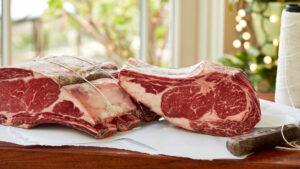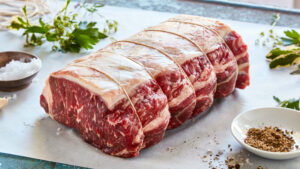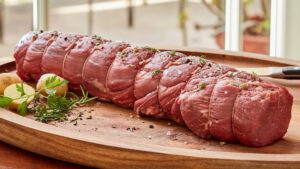

Beefing up your holiday table has never been easier—or more flavorful. The secret? Dry aged beef. You’ll be surprised by just how easy it is to pull off an impressive flavor-packed roast.
This article first appeared in Fine Cooking magazine, December 2021
You could say my father steered me to join the family’s business, Flannery Beef, but I’ll admit that I wasn’t expecting to stay long. At first, he pegged me with an appropriate task for someone in her early twenties (“Can you help me with the website?”), but he simultaneously handed me a knife—and I haven’t put it down since.
Sometimes it takes a trained butcher’s eye to make sure you’re sourcing and serving the best beef for your holiday table, and I am happy to be able to share a few tips and takeaways for making the most of your roast.
Where to begin? Plan ahead, know your ideal portion size per person, and pay attention to beef grades. Does the latter really matter? Yes, because Prime versus Choice makes a real difference. Prime beef is the highest grade and best you can buy, indicated by the abundance of marbling (intramuscular fat) throughout. And holiday time is most certainly prime time.
– Katie Flannery
In case you need a refresher… WHAT IS DRY AGING?
The process uniquely intensifies beef’s natural flavor, while imparting tenderness
Dry aging is a carefully controlled process in which beef primals—whole muscle groups—are aged in a temperature-controlled environment for a specific length of time before they are trimmed and cut into steaks or roasts.
By exposing the meat to air on all sides, dry aging allows the moisture within the meat to slowly evaporate over time, while natural enzymes slowly begin to break down the molecular bonds. It’s this combination of moisture loss and tenderization that improve the beef ’s flavor and texture. The longer it is dry aged, the more pronounced and concentrated the flavor. Thirty to 35 days of aging is the most popular sweet spot, resulting in a slice that is deeply beefy, delicately nutty, and incredibly aromatic. When it comes to seasoning, less is more. Because of the inherent character imparted by dry aging, the meat needs very little intervention from marinades and rubs, and you’ll want to exercise restraint when it comes to sauces. A heavy pinch of kosher salt and a generous grind of black peppercorns before cooking is truly all a dry-aged cut needs. For a holiday table, we like to keep it simple with fresh herbs and natural jus.
Pinpricks of marbling and fat benefit from the acidity of wine, but like seasonings, the wine shouldn’t overpower the nuances of the meat, so seek out a lighter-bodied bottle with subtle fruit. Pinot Noir or Italian reds like Barolo and other Nebbiolo varieties are excellent companions, as are California Cabernet, Bordeaux, and Spanish blends. One rule: the older the vintage, the better. Aged wine with aged steak is as sympatico as Champagne and caviar.
WHAT CUT DO I CHOOSE AND HOW DO I ROAST IT?
Bone-in and standing? Tied up and trussed? Choosing the right roast for a crowd shouldn’t be intimidating, but it’s important to understand the differences. Here are the top three contenders for the center of your table.
RIB ROAST
 A classic and popular choice for special occasions, the prime rib roast is elegant and impressive. With a flair for the dramatic, a full Rib Roast has seven bones, though you can request fewer if you are feeding a smaller crowd. A good rule of thumb for determining portion sizes is to assume 1.25 to 1.5 lbs. (starting weight) per person. That will account for the weight of the bones and the expected shrink loss during cooking. The rib muscle lies between the chuck (the neck of the animal) and the loin (lower back). If serving a smaller roast (less than four ribs) the characteristics of the roast will be slightly different based on where the final cut falls between the two—you could end up with more rib cap (read: fat and flavor) or a meatier piece with less fatty chew. Either way, it’s hard to disappoint.
A classic and popular choice for special occasions, the prime rib roast is elegant and impressive. With a flair for the dramatic, a full Rib Roast has seven bones, though you can request fewer if you are feeding a smaller crowd. A good rule of thumb for determining portion sizes is to assume 1.25 to 1.5 lbs. (starting weight) per person. That will account for the weight of the bones and the expected shrink loss during cooking. The rib muscle lies between the chuck (the neck of the animal) and the loin (lower back). If serving a smaller roast (less than four ribs) the characteristics of the roast will be slightly different based on where the final cut falls between the two—you could end up with more rib cap (read: fat and flavor) or a meatier piece with less fatty chew. Either way, it’s hard to disappoint.
CLUB ROAST
 The New York strip is arguably the most popular of all premier cuts—and for good reason. The fat is evenly distributed along the outer edge and marbled throughout the meat, so every bite is as good as the last. Essentially one large never-ending New York strip, the Club Roast is a winner for guests who tend to be fat-averse, but who appreciate something deeply flavored. In shape and presentation, it will look a little like a tenderloin roast but with a larger diameter. Like a tenderloin, it should be trussed before roasting to help retain its shape so that it is perfectly cooked from edge to edge. And no bone means less fuss, so you’ll reap uniform pieces upon carving. Find our favorite (& easy) recipe here.
The New York strip is arguably the most popular of all premier cuts—and for good reason. The fat is evenly distributed along the outer edge and marbled throughout the meat, so every bite is as good as the last. Essentially one large never-ending New York strip, the Club Roast is a winner for guests who tend to be fat-averse, but who appreciate something deeply flavored. In shape and presentation, it will look a little like a tenderloin roast but with a larger diameter. Like a tenderloin, it should be trussed before roasting to help retain its shape so that it is perfectly cooked from edge to edge. And no bone means less fuss, so you’ll reap uniform pieces upon carving. Find our favorite (& easy) recipe here.
TENDERLOIN ROAST
 As its name suggests, this is the most tender cut you can expect. The muscle is nestled right next to the spine of the animal, and the veritable lack of movement during the animal’s lifetime is what causes it to be so inherently tender. Because of its lean quality, this roast benefits from playful sauces and accoutrements, so whip up your best béarnaise or red wine reduction. The smaller diameter allows for petite portion sizes (a safe rule of thumb is 1/2 a pound per serving) and leaves plenty of room on the plate for splendid sides. As the smallest of the main three roasts, the largest sized roast we can do is 2.5lbs when cut from our California Reserve beef and 3lbs when cut from our Midwestern. If you are feeding a larger group, aim to get 2 equal-sized roasts—such as two 3-lb. roasts for 12 servings. The diameter or thickness of the roast is what will ultimately determine its cook time, not weight. Feeling adventurous? The tenderloin makes for a picture-perfect Beef Wellington.
As its name suggests, this is the most tender cut you can expect. The muscle is nestled right next to the spine of the animal, and the veritable lack of movement during the animal’s lifetime is what causes it to be so inherently tender. Because of its lean quality, this roast benefits from playful sauces and accoutrements, so whip up your best béarnaise or red wine reduction. The smaller diameter allows for petite portion sizes (a safe rule of thumb is 1/2 a pound per serving) and leaves plenty of room on the plate for splendid sides. As the smallest of the main three roasts, the largest sized roast we can do is 2.5lbs when cut from our California Reserve beef and 3lbs when cut from our Midwestern. If you are feeding a larger group, aim to get 2 equal-sized roasts—such as two 3-lb. roasts for 12 servings. The diameter or thickness of the roast is what will ultimately determine its cook time, not weight. Feeling adventurous? The tenderloin makes for a picture-perfect Beef Wellington.
THE TIME TO SEAR
The ratio of fat to muscle is the key to navigating the best cooking method. Outer fat and marbling contribute to the final flavor and texture, so the most appropriate method depends on how you want that fat to melt. A rich cap of fat that crowns a rib roast, for instance, crisps up with a blast of high heat at first, then is set to render slowly for the remainder of cooking. By contrast, a leaner tenderloin can benefit from a reverse sear in which the meat is roasted first slowly at a lower temperature (250°F to 275°F) then finished on high heat (around 450°F) to achieve browned edges. The result is an evenly rosy interior from edge to edge with a well caramelized crust all around.
